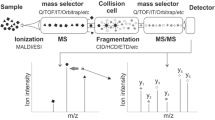Abstract
A proteomics approach was evaluated for analysis of photosyntheis-related proteins that are characteristic of chromatophores, particles derived from purple phototrophic bacterial intracytoplasmic membranes. Proteins of purified chromatophores from Rhodopseudomonas palustris were solubilized and digested with trypsin, to create a collection of peptides that were fractionated by liquid chromatography. Peptide sequences were determined and assigned to specific proteins by analysis of tandem mass spectra of peptides, and comparison to a library derived from the recently determined R. palustris genome sequence. A total of 300 proteins were detected with a probability value ≥0.9, and the number of proteins detected increased to 345 when the minimum probability value was reduced to 0.5. Membrane–integral proteins of the reaction center, cytochrome b/c 1, light-harvesting and ATPase complexes were used as controls to assess how well this approach performs with hydrophobic proteins. New genes were identified, and tentatively designated as encoding photosynthesis-related proteins. We conclude that this approach is a powerful method to evaluate the possible existence of new photosynthesis-related proteins (and genes), although alternative methods are needed to evaluate the exact functions of newly discovered genes.
Similar content being viewed by others
References
Aebersold R and Goodlett DR (2001) Mass spectrometry in proteomics. Chem Rev 101: 69–95
Cogdell RJ, Isaacs NW, Howard TD, McLuskey K, Fraser NJ and Prince SM (1999) How photosynthetic bacteria harvest solar energy. J Bacteriol 181: 3869–3879
Drews G and Golecki JR (1995) Structure, molecular organization, and biosynthesis of membranes of purple bacteria. In: Blankenship RE, Madigan MT and Bauer CE (eds) Anoxygenic Photosynthetic Bacteria, pp 231–257. Kluwer Academic Publishers, Dordrecht, The Netherlands
Eng JK, McCormack AL and Yates JR (1994) An approach to correlate tandem mass spectral data of peptides with amino acid sequences in a protein database. J Am Soc Mass Spectrom 5: 976
Goodlett DR, Bruce JE, Anderson GA, Rist B, Pasa-Tolic L, Fiehn O, Smith RD and Aebersold R (2000) Protein identification with a single accurate mass of a cysteine-containing peptide and constrained database searching. Anal Chem 72: 1112–1122
Harwood CS and Gibson J (1986) Uptake of benzoate by Rhodopseudomonas palustris grown anaerobically in light. J Bacteriol 165: 504–509
Hippler M, Klein J, Fink A, Allinger T and Hoerth P (2001) Towards functional proteomics of membrane protein complexes: analysis of thylakoid membranes from Chlamydomonas reinhardtii. Plant J 28: 595–606
Keller A, Nesvizhskii AI, Kolker E and Aebersold R (2002) Empirical statistical model to estimate the accuracy of peptide identifications made by MS/MS and database search. Anal Chem 74: 5383–5392
Kim M-K and Harwood CS (1991) Regulation of benzoate-CoA ligase in Rhodopseudomonas palustris. FEMS Microbiol Lett 83: 199–204
Lancaster CRD, Ermler U and Michel H (1995) The structures of photosynthetic reaction centers from purple bacteria as revealed by X-ray crystallography. In: Blankenship RE, Madigan MT and Bauer CE (eds) Anoxygenic Photosynthetic Bacteria, pp 503–526. Kluwer Academic Publishers, Dordrecht, The Netherlands
Lilburn TG, Prince RC and Beatty JT (1995) Mutation of the Ser2 codon of the light-harvesting B870 ? polypeptide of Rhodobacter capsulatus partially suppresses the pufX phenotype. J Bacteriol 177: 4593–4600
Link AJ, Eng J, Schieltz DM, Carmack E, Mize GJ, Morris DR, Garvik BM and Yates JR (1999) Direct analysis of protein complexes using mass spectrometry. Nat Biotechnol 17: 676–682
Loach PA (2000)Supramolecular complexes in photosynthetic bacteria.Proc Natl Acad Sci USA97:5016–5018
Meyer TE and Donohue TJ (1995) Cytochromes, iron–sulfur, and copper proteins mediating electron transfer from the cyt bc1 complex to photosynthetic reaction center complexes. In: Blankenship RE, Madigan MT and Bauer CE(eds),Anoxygenic Photosynthetic Bacteria pp 725–745.Kluwer Academic Publishers, Dordrecht, The Netherlands
Okamura MY, Paddock ML, Graige MS and Feher G (2000) Proton and electron transfer in bacterial reaction centers. Biochim Biophys Acta 1458: 148–163
Ouellette AJA and Barry BA (2002) Tandem mass spectrometric identification of spinach Photosystem II light-harvesting components. Photosynth Res 72: 159–173
Patton WF, Schulenberg B and Steinberg TH (2002) Twodimensional gel electrophoresis; better than a poke in the ICAT? Curr Opin Biotech 13: 321–328
Prince RC (1990) Bacterial photosynthesis: from photons to Δp. Bacteria 12: 111–149
Prince RC, Baccarini-Melandri A, Hauska GA, Melandri BA and Crofts AR (1975) Asymmetry of an energy transducing membrane: the location of cytochrome c2 in Rhodopseudomonas sphaeroides and Rhodopseudomonas capsulata. Biochim Biophys Acta 387: 212–227
Tadros MH, Katsiou E, Hoon MA, Yurkova N and Ramji DP (1993) Cloning of a new antenna gene cluster and expression analysis of the antenna gene family of Rhodopseudomonas palustris. Eur J Biochem 217: 867–875
Thöny-Meyer L, James P and Hennecke H (1991) Frome one gene to two proteins: the biogenesis of cytochromes b and c1 in Bradyrhizobium japonicum. Proc Natl Acad Sci USA 88: 5001–5005
Varga AR and Staehelin LA (1983) Spatial differences in photosynthetic and non-photosynthetic membranes of Rhodopseudomonas palustris. J Bacteriol 154: 1414–1430
Varga AR and Staehelin LA (1985) Pigment–protein complexes from Rhodopseudomonas palustris: isolation, characterization and reconstitution into liposomes. J Bacteriol 161: 921–927
Yi EC, Lee H, Purvine SO, Aebersold R and Goodlett DR (2002) Approaching complete peroxisome charcterization by gas-phase fractionation. Electrophoresis 23: 3205–3216
Zannoni D (1995) Aerobic and anaerobic electron transport chains in anoxygenic phototrophic bacteria. In: Blankenship RE, Madigan MT and Bauer CE (eds) Anoxygenic Photosynthetic Bacteria, pp 949–971. Kluwer Academic Publishers, Dordrecht, The Netherlands
Author information
Authors and Affiliations
Rights and permissions
About this article
Cite this article
Fejes, A.P., Yi, E.C., Goodlett, D.R. et al. Shotgun proteomic analysis of a chromatophore-enriched preparation from the purple phototrophic bacterium Rhodopseudomonas palustris . Photosynthesis Research 78, 195–203 (2003). https://doi.org/10.1023/B:PRES.0000006752.81486.74
Issue Date:
DOI: https://doi.org/10.1023/B:PRES.0000006752.81486.74




